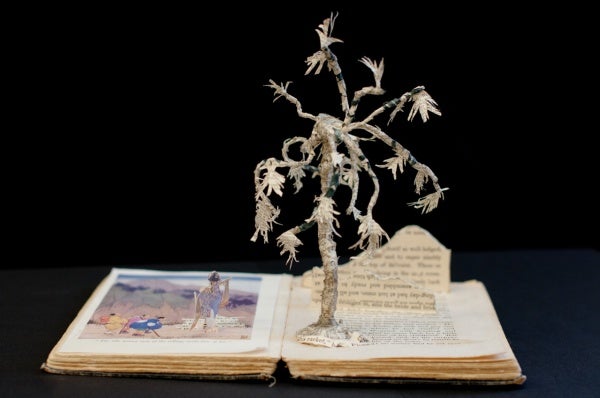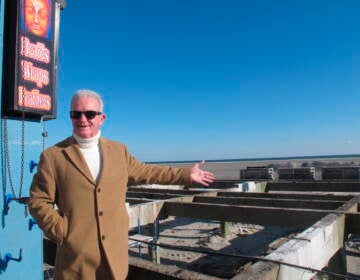For Trenton, art is the center of the comeback
Trenton Makes: I conjure New Jersey’s capital city in its heyday, when it had more than 50 pottery manufacturers and was an industrial powerhouse, with Roebling Wireworks churning out bridges and elevators, even Slinkies.
This is part of a series from Ilene Dube of The Artful Blogger.
Trenton Makes: I conjure New Jersey’s capital city in its heyday, when it had more than 50 pottery manufacturers and was an industrial powerhouse, with Roebling Wireworks churning out bridges and elevators, even Slinkies.
The city fell on hard times during urban flight, and has been struggling to make its comeback through the years. In pockets such as Mill Hill, the Island and Cadwalader Heights, enterprising young professionals restored old homes and neighborhoods.
At the center of the comeback is the arts, luring people downtown and spurring growth of such businesses as restaurants and shops. Even as the city struggles with its nationally reported toilet paper shortage and its mayor’s home and office raided by the FBI, organizations like Passage Theatre, Artworks, the New Jersey State Museum and the Trenton City Museum at Ellarslie continue to “make what Trenton should be making,” says playwright and Trenton Artists Workshop Association founding member Dan Aubrey.
“We’re trying to build a community of people who care. The city didn’t do it, we did.”
Trenton Makes
Trenton Makes is also the title of the Trenton Artists Workshop Association’s summer exhibit at Ellarslie. To get to the museum I enter Cadwalader Park under the arch formed by stone walls and a model of the Trenton Makes Bridge. Just under the arch hangs a banner proclaiming the name of Trenton Mayor Tony Mack. Huh?
Turns out the sign and the mock bridge are just one of the latest scandals of Mack’s administration. The $17,000 sign will be removed because approvals were never sought from the Landmarks Commission — Cadwalader Park, designed by Frederick Law Olmsted of Central Park design team Olmsted and Vaux, is on the National Register of Historic Places.
But onward to Trenton Makes.
This is the first exhibit held in the museum since Ellarslie Director Brian Hill was fired by Mack last fall, due to budget cuts. (The museum’s annual juried Ellarslie Open was downsized this year to a fundraising event to help hire Bob Sands as part-time director.)
As I walk up the front path to the 1848 Italianate villa, turned into a museum in the 1970s after a stint as a monkey house, I notice the garden isn’t as well tended as when the museum had a full-time director, an assistant and a custodian. Although it lacks the magical air of better times, Ellarslie still has vestiges of its glory days.
Inside the museum, Sands greets me and explains how he had been an intern when Hill was still at the helm, then served as interim director when it became clear that Mack’s appointee knew nothing about running a museum. Commuting an hour from Glassboro, Sands also directs the Trent House part-time. He appears happy to be here and says he loves the work.
A new generation of artists
Trenton’s new generation of artists, influenced by graffiti — Leon Rainbow and Will Kasso — are represented in Trenton Makes as well as 92-year-old Jon Naar, who photographs graffiti and has written a book on it. He’s captured Rainbow at work, arms filled with spray cans.
Former director Hill, now working at a museum in Alabama, was known for the quality of his installations, and would be happy to see the tradition continued. Rainbow’s graffitied letters of the show’s title in the entry leads a viewer to the mathematically conceived optical effects of Andrew Werth’s “Creation,” and next to that, William B. Hogan’s Tahiti-esque painting of a dancing figure and a hot tropical flower in bloom.
In the Tom Malloy Gallery, photographs by Aubrey Kauffman, Lizz Wells and Josh Brilliant evoke urban wasteland. Large walls of gray cinderblock, fences that block the light and white lines on black asphalt find poetic interplay in the photographs by Kauffman. In a series “I’m So Tired,” Wells finds sleeping people, possibly homeless, and silkscreens the white images on black canvas. Brilliant finds a plane landed in the woods, its door ajar, and an RV alone in a field – these are about last trips.
In the main gallery, Elizabeth Aubrey’s softened cityscape, with houses that almost look like Hobbit huts, is paired with Marina Ahun’s photorealistic oil painting of a bridge connecting two glass buildings, reflecting each other in wavy lines.
Storyteller, curator and artist Rebecca Kelly, who recently moved from Ringoes to New York City, has created an altered book, “The Wooden Bowl,” opened to an illustration of three men with the Himalayas in the background, the caption reading “The idle young men of the village made fun of her.” The “her” character has risen from the page, carrying weights in her hands, and on the facing page a tree made of the book’s paper has risen, with hands reaching eerily out of all its branches.
Painter Joe Kazimierczyk reminds us that although we are in the capital city, we are surrounded by trees, parks and rivers in “Raritan River Crossing.”
There is so much color, texture and form here, from Judy Tobie’s handmade paper “Mother Night,” a ganglion of spiky ovules nested within each other, to Susan Kubota’s “Two Idol Sisters,” made from slivers of wooden debris painted gold, scarified and outfitted with facial features; from Fran Mollett’s “Trifle for Thanksgiving” in a glass dish atop a red tablecloth under a pink lampshade against a blue wall with white louvred shades, to Donna Payton’s universe of toy figures — art critic Gerard Haggerty, who served as juror, picked well.
In the final room, we see a conversation between Mel Leipzig — considered one of the state’s finest living painters — and fellow artists Harry Naar and Jon Naar. Leipzig paints Harry in a triptych with his wife and two adult sons, and Jon in a diptych, surrounded by his photographs of Andy Warhol and Josef Albers, with whom Leipzig studied at Yale. It was a difficult time for Leipzig, a died-in-the-wool realist coming of age at the dawn of Abstract Expressionism. That he can paint Albers as realistically as a black-and-white photograph is divine retribution.
Leipzig is a master at telling a person’s story through the elements of their environment, be it messy stuff exploding out of drawers, paint dribbled on an easel (he paints a lot of artists, as well as architects), books and photographs. In Harry’s studio, Leipzig reproduces his canvases — intricately drawn woods, with snarls and tangles of branches. He even uses Harry’s pen to do so.
In Leipzig’s realist portrayals, life becomes art, but in this gallery, art becomes life. Some of the photographs of Jon Naar, the drawings of Harry Naar and the film posters of Harry’s son, Aaron, appear on the opposite walls. Leipzig and Harry and Jon Naar will come together August 19, 1-4 pm, to talk about their relationship, collaboration and interaction, at the Trenton City Museum at Ellarslie, Cadwalader Park, Trenton.
The Artful Blogger is written by Ilene Dube and offers a look inside the art world of the greater Princeton area. Ilene Dube is an award-winning arts writer and editor, as well as an artist, curator and activist for the arts.
WHYY is your source for fact-based, in-depth journalism and information. As a nonprofit organization, we rely on financial support from readers like you. Please give today.








